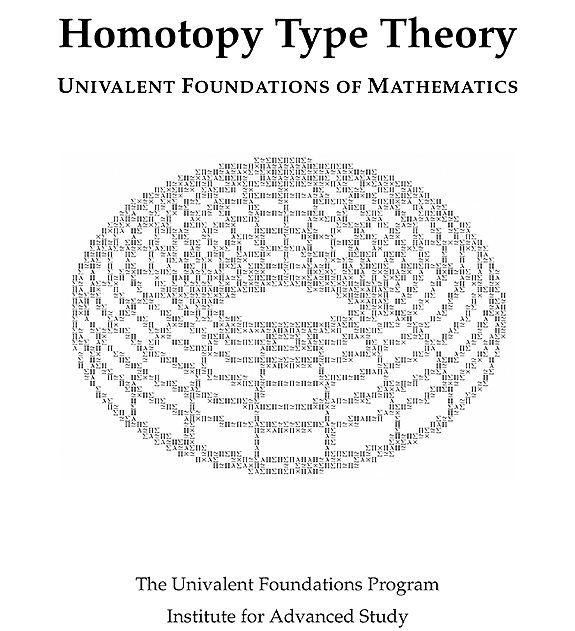The following text is excerpted from the introduction to the book Homotopy Type Theory: Univalent Foundations of Mathematics, written jointly by the participants of the special year on univalent foundations, which may be obtained at http://homotopytypetheory.org/book/.
Homotopy type theory is a new branch of mathematics that combines aspects of several different fields in a surprising way. It is based on a recently discovered connection between homotopy theory and type theory. Homotopy theory is an outgrowth of algebraic topology and homological algebra, with relationships to higher category theory, while type theory is a branch of mathematical logic and theoretical computer science. Although the connections between the two are currently the focus of intense investigation, it is increasingly clear that they are just the beginning of a subject that will take more time and more hard work to fully understand. It touches on topics as seemingly distant as the homotopy groups of spheres, the algorithms for type checking, and the definition of weak ∞-groupoids.
Homotopy type theory also brings new ideas into the very foundation of mathematics. On the one hand, there is Voevodsky’s subtle and beautiful univalence axiom. The univalence axiom implies, in particular, that isomorphic structures can be identified, a principle that mathematicians have been happily using on workdays, despite its incompatibility with the “official” doctrines of conventional foundations. On the other hand, we have higher inductive types, which provide direct, logical descriptions of some of the basic spaces and constructions of homotopy theory: spheres, cylinders, truncations, localizations, etc. When combined in homotopy type theory, these innovations permit an entirely new kind of “logic of homotopy types.”
This suggests a new conception of foundations of mathematics with intrinsic homotopical content, an “invariant” conception of the objects of mathematics, and convenient machine implementations, which can serve as a practical aid to the working mathematician. This is the univalent foundations program. The present book is intended as a first systematic exposition of the basics of univalent foundations and a collection of examples of this new style of reasoning—but without requiring the reader to know or learn any formal logic or to use any computer proof assistant.
We emphasize that homotopy type theory is a young field, and univalent foundations is very much a work in progress. This book should be regarded as a “snapshot” of the state of the field at the time it was written, rather than a polished exposition of an established edifice. As we will discuss briefly later, there are many aspects of homotopy type theory that are not yet fully understood—but as of this writing, its broad outlines seem clear enough. The eventual theory will probably not look exactly like the one described in this book, but it will certainly be at least as capable and powerful; given the results presented here, we therefore believe that univalent foundations could eventually replace set theory as the “implicit foundation” for the un-formalized mathematics done by most mathematicians.
The basic idea of the univalence axiom can be explained as follows. In type theory, one can have a universe U, the terms of which are themselves types, A:U, etc. Those types that are terms of U are commonly called small types. Like any type, U has an identity type IdU, which expresses the identity relation A = B between small types. Thinking of types as spaces, U is a space, the points of which are spaces; to understand its identity type, we must ask, what is a path between spaces in U? The univalence axiom says that such paths correspond to homotopy equivalences A ≃ B. At the risk of oversimplifying, we can state this succinctly as follows:
Univalence Axiom: (A = B) ≃ (A ≃ B).
In other words, identity is equivalent to equivalence. In particular, one may say that “equivalent types are identical.”
From the homotopical point of view, univalence implies that spaces of the same homotopy type are connected by a path in the universe U, in accord with the intuition of a classifying space for (small) spaces. From the logical point of view, however, it is a radically new idea: it says that isomorphic things can be identified! Mathematicians are of course used to identifying isomorphic structures in practice, but they generally do so by “abuse of notation,” or some other informal device, knowing that the objects involved are not “really” identical. But in this new foundational scheme, such structures can be formally identified, in the logical sense that every property or construction involving one also applies to the other. Indeed, the identification is now made explicit and properties and constructions can be systematically transported along it. Moreover, the different ways in which such identifications may be made themselves form a structure that one can (and should!) take into account.
By using the identification of paths with identities in homotopy type theory, these sorts of “inductively defined spaces” can be characterized in type theory by “induction principles,” entirely analogous to classical examples such as the natural numbers and the disjoint union. The resulting higher inductive types give a direct “logical” way to reason about familiar spaces such as spheres, which (in combination with univalence) can be used to perform familiar arguments from homotopy theory, such as calculating homotopy groups of spheres, in a purely formal way. The resulting proofs are a marriage of classical homotopy-theoretic ideas with classical type-theoretic ones, yielding new insight into both disciplines.
Moreover, this is only the tip of the iceberg: many abstract constructions from homotopy theory, such as homotopy colimits, suspensions, Postnikov towers, localization, completion, and spectrification, can also be expressed as higher inductive types. . . . Thus, the combination of univalence and higher inductive types suggests the possibility of a revolution, of sorts, in the practice of homotopy theory.

One difficulty often encountered by the classical mathematician when faced with learning about type theory is that it is usually presented as a fully or partially formalized deductive system. This style, which is very useful for proof-theoretic investigations, is not particularly convenient for use in applied, informal reasoning. Nor is it even familiar to most working mathematicians, even those who might be interested in foundations of mathematics. One objective of the present work is to develop an informal style of doing mathematics in univalent foundations that is at once rigorous and precise, but is also closer to the language and style of presentation of everyday mathematics.
In present-day mathematics, one usually constructs and reasons about mathematical objects in a way that could in principle, one presumes, be formalized in a system of elementary set theory, such as ZFC (the Zermelo–Fraenkel axioms plus the axiom of choice)—at least given enough ingenuity and patience. For the most part, one does not even need to be aware of this possibility, since it largely coincides with the condition that a proof be “fully rigorous” (in the sense that all mathematicians have come to understand intuitively through education and experience). But one does need to learn to be careful about a few aspects of “informal set theory”: the use of collections too large or inchoate to be sets; the axiom of choice and its equivalents; even (for undergraduates) the method of proof by contradiction; and so on. Adopting a new foundational system such as homotopy type theory as the implicit formal basis of informal reasoning will require adjusting some of one’s instincts and practices. The present text is intended to serve as an example of this “new kind of mathematics,” which is still informal, but could now in principle be formalized in homotopy type theory, rather than ZFC, again given enough ingenuity and patience.
It is worth emphasizing that, in this new system, such formalization can have real practical benefits. The formal system of type theory is suited to computer systems and has been implemented in existing proof assistants. A proof assistant is a computer program that guides the user in construction of a fully formal proof, only allowing valid steps of reasoning. It also provides some degree of automation, can search libraries for existing theorems, and can even extract numerical algorithms from the resulting (constructive) proofs.
We believe that this aspect of the univalent foundations program distinguishes it from other approaches to foundations, potentially providing a new practical utility for the working mathematician. Indeed, proof assistants based on older type theories have already been used to formalize substantial mathematical proofs, such as the four-color theorem and the Feit–Thompson theorem. Computer implementations of univalent foundations are presently works in progress (like the theory itself). However, even its currently available implementations (which are mostly small modifications to existing proof assistants such as Coq) have already demonstrated their worth, not only in the formalization of known proofs but in the discovery of new ones. Indeed, many of the proofs described in this book were actually first done in a fully formalized form in a proof assistant and are only now being “unformalized” for the first time—a reversal of the usual relation between formal and informal mathematics
One can imagine a not-too-distant future when it will be possible for mathematicians to verify the correctness of their own papers by working within the system of univalent foundations, formalized in a proof assistant, and that doing so will become as natural as typesetting their own papers in TeX. (Whether this proves to be the publishers’ dream or their nightmare remains to be seen.) In principle, this could be equally true for any other foundational system, but we believe it to be more practically attainable using univalent foundations, as witnessed by the present work and its formal counterpart.
